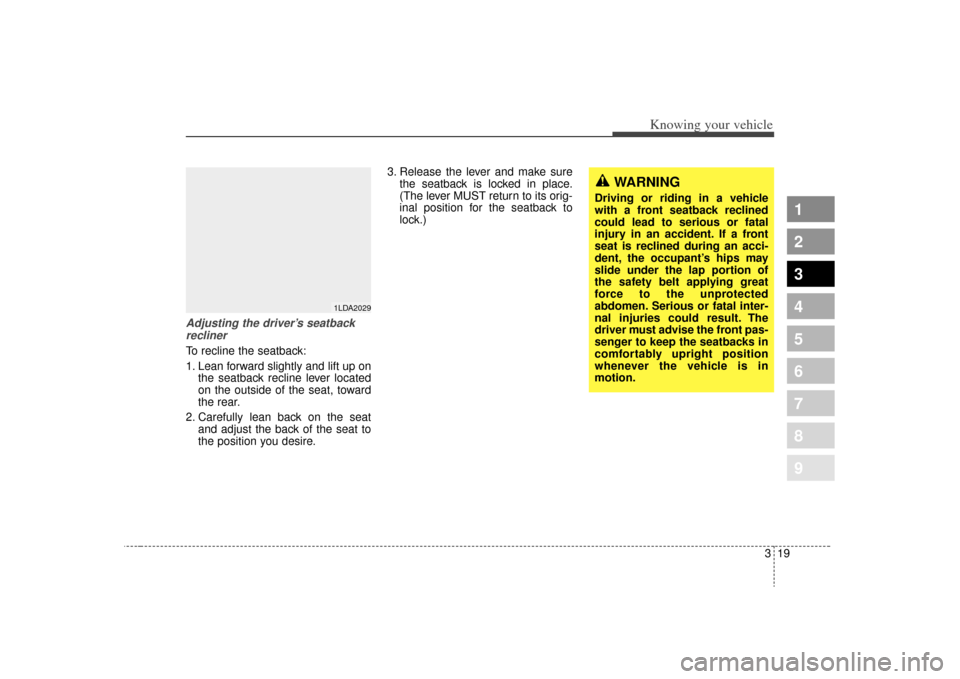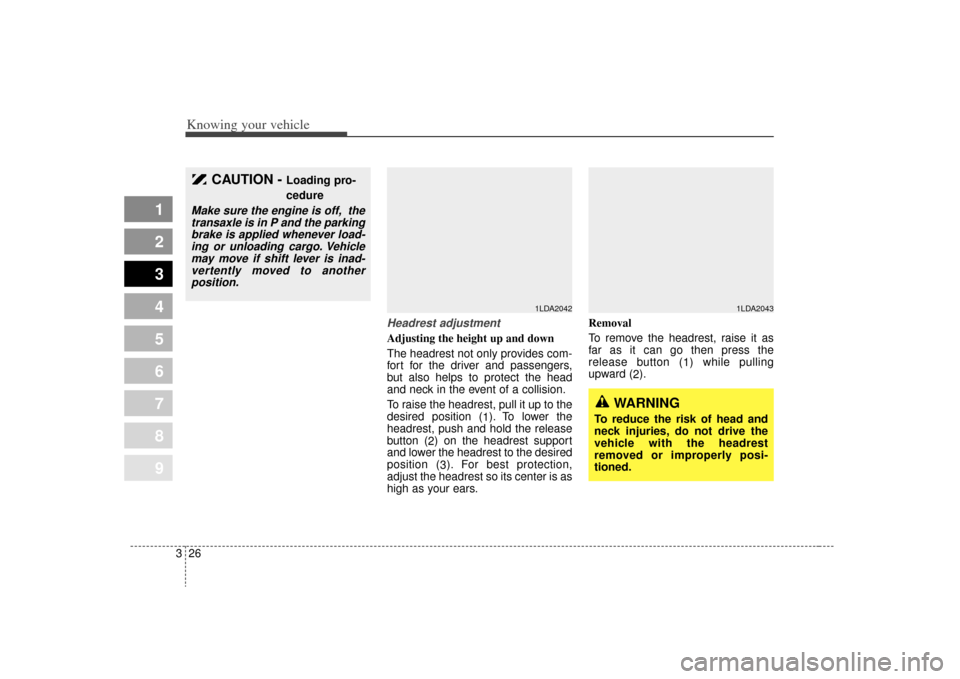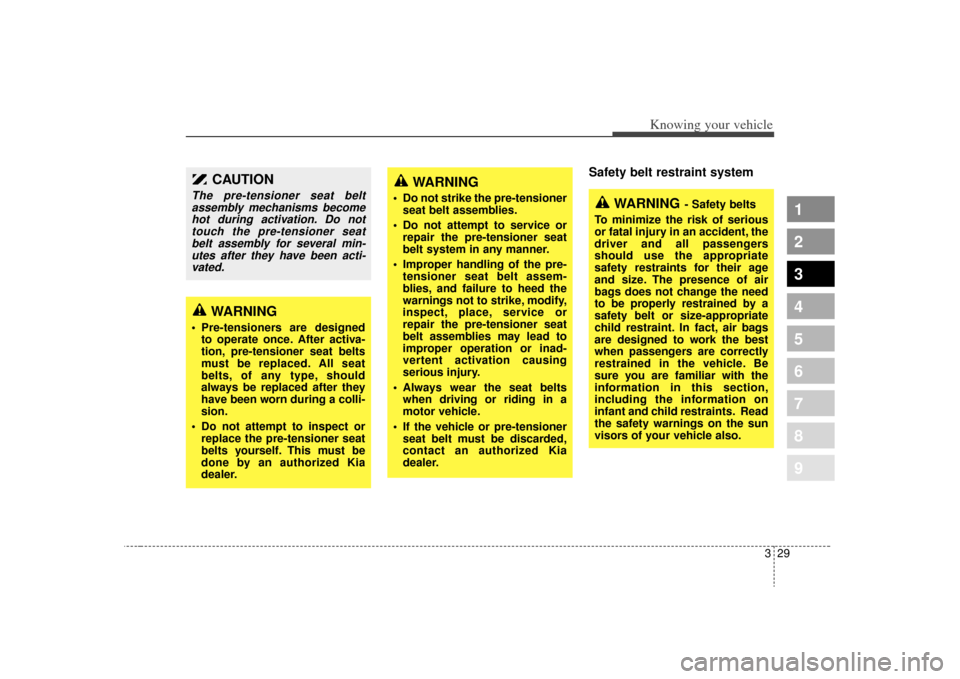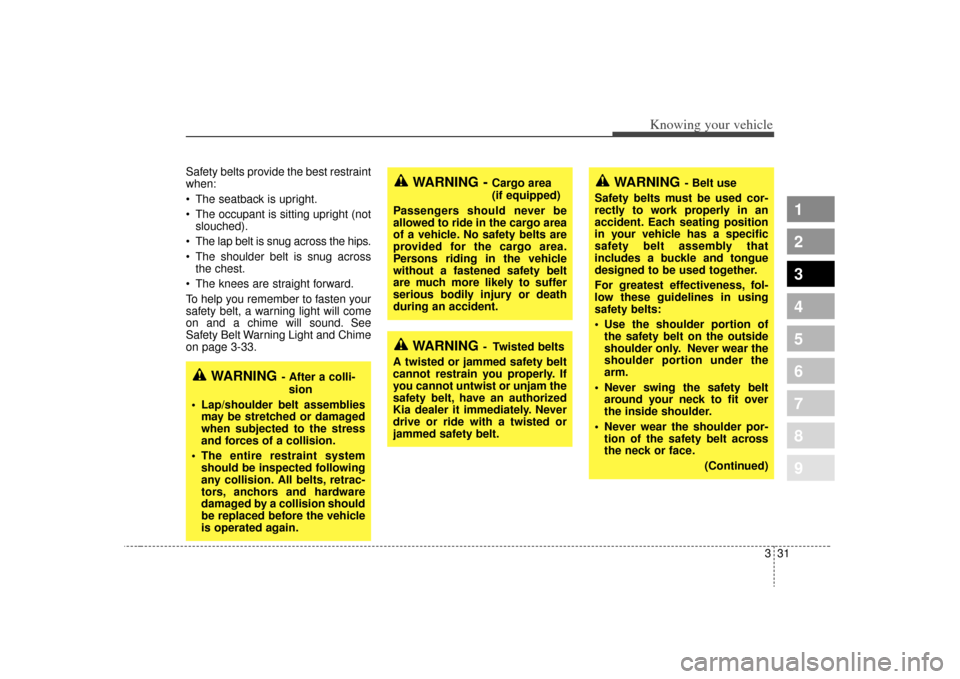warning KIA Sephia 2009 2.G User Guide
[x] Cancel search | Manufacturer: KIA, Model Year: 2009, Model line: Sephia, Model: KIA Sephia 2009 2.GPages: 291, PDF Size: 2.63 MB
Page 29 of 291

319
1
2
3
4
5
6
7
8
9
Knowing your vehicle
Adjusting the driver’s seatbackreclinerTo recline the seatback:
1. Lean forward slightly and lift up on the seatback recline lever located
on the outside of the seat, toward
the rear.
2. Carefully lean back on the seat and adjust the back of the seat to
the position you desire. 3. Release the lever and make sure
the seatback is locked in place.
(The lever MUST return to its orig-
inal position for the seatback to
lock.)
1LDA2029
WARNING
Driving or riding in a vehicle
with a front seatback reclined
could lead to serious or fatal
injury in an accident. If a front
seat is reclined during an acci-
dent, the occupant’s hips may
slide under the lap portion of
the safety belt applying great
force to the unprotected
abdomen. Serious or fatal inter-
nal injuries could result. The
driver must advise the front pas-
senger to keep the seatbacks in
comfortably upright position
whenever the vehicle is in
motion.
Page 30 of 291

Knowing your vehicle20
3
1
2
3
4
5
6
7
8
9
Headrest adjustmentAdjusting the height up and down
The headrest not only provides com-
fort for the driver and passengers,
but also helps to protect the head
and neck in the event of a collision.
To raise the headrest, pull it up to the
desired position (
1). To lower the
headrest, push and hold the release
button ( 2) on the headrest support
and lower the headrest to the desired
position ( 3). For best protection,
adjust the headrest so its center is as
high as your ears. Removal
To remove the headrest, raise it as
far as it can go then press the
release button (
1) while pulling
upward ( 2). Active headrest (if equipped)
The active headrest is designed to
move forward and upward during a
rear impact. This helps to prevent the
driver's and front passenger’s head
from moving backward and thus
helps prevent neck injuries.
1LDA2033
1LDA2034
WARNING
To reduce the risk of head and
neck injuries, do not drive the
vehicle with the headrest
removed or improperly posi-
tioned.
Do not adjust the driver’s head-
rest while driving.
HNF2041-1
Page 31 of 291

321
1
2
3
4
5
6
7
8
9
Knowing your vehicle
Adjusting the front passenger
seatForward/backward positionadjustmentTo move the seat forward or back-
ward:
1. Pull the seat slide adjustment
lever under the front edge of the
seat cushion up and hold it.
2. Slide the seat to the position you desire.
3. Release the lever and make sure the seat is locked in place. Adjust the seat before driving, and
make sure the seat is locked secure-
ly by trying to move forward and
backward without using the lever. If
the seat moves, it is not locked prop-
erly.
Adjusting seatback reclinerTo recline the seatback:
1. Lean forward slightly and lift up on
the seatback recline lever located
on the outside of the seat, toward
the rear.
2. Carefully lean back on the seat and adjust the back of the seat to
the position you desire.
3. Release the lever and make sure the seatback is locked in place.
(The lever MUST return to its orig-
inal position for the seatback to
lock.)
1LDA2035
WARNING
In order to avoid unnecessary
air bag injuries including the
possibility of severe injury or
death, always sit as far back as
possible by moving the seat far
back, while still maintaining
good vehicle control. Serious
injury or death may be caused
due to the deployment of the
passenger’s air bag.
1LDA2036
Page 32 of 291

Knowing your vehicle22
3
1
2
3
4
5
6
7
8
9
Headrest adjustmentAdjusting the height up and down
The headrest not only provides com-
fort for the driver and passengers,
but also helps to protect the head
and neck in the event of a collision.
To raise the headrest, pull it up to the
desired position (
1). To lower the
headrest, push and hold the release
button ( 2) on the headrest support
and lower the headrest to the desired
position ( 3). For best protection,
adjust the headrest so its center is as
high as your ears. Removal
To remove the headrest, raise it as
far as it can go then press the
release button (
1) while pulling
upward ( 2).
WARNING
- Driver
responsibility for front seat
passenger
Driving or riding in a vehicle
with a front seatback reclined
could lead to serious or fatal
injury in an accident. If a front
seat is reclined, the occupant’s
hips may slide under the lap
portion of the safety belt apply-
ing great force to the unprotect-
ed abdomen. Serious or fatal
internal injuries could result.
Keep the seatbacks in a com-
fortably upright position when-
ever the vehicle is in motion.
1LDA2033A
1LDA2034A
WARNING
To reduce the risk of head and
neck injuries, do not drive the
vehicle with the headrest
removed or improperly posi-
tioned.
Page 35 of 291

325
1
2
3
4
5
6
7
8
9
Knowing your vehicle
✽ ✽NOTICEWhen you fold the rear seatback or
put luggage on the rear seat cushion,
insert the buckle in the pocket
between the rear seatback and cush-
ion. Doing so can prevent the buckle
from being damaged by the rear
seatback or luggage.
To unfold the rear seat:1. Move the rear center shoulder belt
(1) to the side so that it is clear of
the seatback.
2. Lift and push the seatback back- ward firmly until it clicks into place
(2).
Move and push the seat cushion
downward firmly to the proper
position (5 Door, if equipped).
3. Replace the rear safty belt to the proper position.
✽ ✽NOTICEIf the seat belt is locked during the
seatback folding, pull out and
retract the seat belt to release it.
1LDN3026A
1LDN3026B
CAUTION
When returning the rear seat-
backs to the upright position,remember to return the rearshoulder belts to their properposition.
Do not remove the floor carpet in your vehicle. Emission con-trol system componentscause high exhaust tempera-tures under the floor.
WARNING
- Cargo danger
Cargo should always be
secured to prevent it from shift-
ing and causing injury to the
vehicle occupants.
Page 36 of 291

Knowing your vehicle26
3
1
2
3
4
5
6
7
8
9
Headrest adjustment Adjusting the height up and down
The headrest not only provides com-
fort for the driver and passengers,
but also helps to protect the head
and neck in the event of a collision.
To raise the headrest, pull it up to the
desired position (
1). To lower the
headrest, push and hold the release
button ( 2) on the headrest support
and lower the headrest to the desired
position ( 3). For best protection,
adjust the headrest so its center is as
high as your ears. Removal
To remove the headrest, raise it as
far as it can go then press the
release button (
1) while pulling
upward ( 2).
1LDA2042
WARNING
To reduce the risk of head and
neck injuries, do not drive the
vehicle with the headrest
removed or improperly posi-
tioned.
1LDA2043
CAUTION -
Loading pro-
cedure
Make sure the engine is off, the
transaxle is in P and the parkingbrake is applied whenever load-ing or unloading cargo. Vehiclemay move if shift lever is inad-vertently moved to anotherposition.
Page 37 of 291

327
1
2
3
4
5
6
7
8
9
Knowing your vehicle
Pre-tensioner seat beltYour vehicle is equipped with driver’s
and front passenger’s pre-tensioner
seat belts. The purpose of the pre-
tensioner is to make sure that the
seat belts fit tightly against the occu-
pant’s body in certain frontal colli-
sions. The pre-tensioner seat belts
can be activated together with the air
bags, where the frontal collision is
severe enough.When the vehicle stops suddenly, or
if the occupant tries to lean forward
too quickly, the seat belt retractor will
lock into position. In certain frontal
collisions, the pre-tensioner will acti-
vate and pull the seat belt into tighter
contact against the occupant's body.
If the system senses excessive seat
belt tension on the driver or passen-
ger's seat belt when the pre-tension-
er activates, the load limiter inside
the pre-tensioner will release some
of the pressure on the affected seat
belt. (if equipped)
The seat belt pre-tensioner system
consists mainly of the following com-
ponents. Their locations are shown in
the illustration.
(1)
SRS airbag warning light
(2) Seatbelt pre-tensioner assembly
(3) SRS airbag control moduleSAFETY BELTS
2GHB3002
2GHB3001
1
2
3
Page 38 of 291

Knowing your vehicle28
3
1
2
3
4
5
6
7
8
9
✽ ✽
NOTICE• Both the driver's and front pas-
senger's pre-tensioner seat belts
will be activated in certain frontal
collisions. The pre-tensioner seat
belts can be activated, where the
frontal collision is severe enough,
together with the air bags.
• When the pre-tensioner seat belts are activated, a loud noise may be
heard and fine dust, which may
appear to be smoke, may be visible
in the passenger compartment.
These are normal operating condi-
tions and are not hazardous.
• Although it is harmless, the fine dust may cause skin irritation and
should not be breathed for pro-
longed periods. Wash all exposed
skin areas thoroughly after an
accident in which the pre-tension-
er seat belts were activated.
WARNING
To obtain maximum benefit from
a pre-tensioner seat belt:
The seat belt must be worn
correctly.
The seat belt must be adjusted to the correct position.
CAUTION
Because the sensor that acti- vates the SRS air bag is con-nected with pre-tensioner seatbelt, the SRS air bag warninglight on the instrument panelwill blink or illuminate forapproximately 6 seconds afterthe ignition key has beenturned to the “ON” position,then the light should go off.
If the pre-tensioner seat belt is not working properly, thiswarning light will illuminateeven if there is no malfunctionof SRS air bag system. If theSRS air bag warning lightdoes not illuminate when theignition key is turned to “ON”,or if it remains illuminatedafter blinking or illuminatingfor approximately 6 seconds,or if it illuminates while thevehicle is being driven, pleasehave an authorized Kia dealerinspect the pre-tensioner seatbelt or SRS air bag system assoon as possible.
Page 39 of 291

329
1
2
3
4
5
6
7
8
9
Knowing your vehicle
Safety belt restraint system
WARNING
Pre-tensioners are designedto operate once. After activa-
tion, pre-tensioner seat belts
must be replaced. All seat
belts, of any type, should
always be replaced after they
have been worn during a colli-
sion.
Do not attempt to inspect or replace the pre-tensioner seat
belts yourself. This must be
done by an authorized Kia
dealer.
CAUTION
The pre-tensioner seat beltassembly mechanisms becomehot during activation. Do nottouch the pre-tensioner seatbelt assembly for several min-utes after they have been acti-vated.
WARNING
Do not strike the pre-tensioner seat belt assemblies.
Do not attempt to service or repair the pre-tensioner seat
belt system in any manner.
Improper handling of the pre- tensioner seat belt assem-
blies, and failure to heed the
warnings not to strike, modify,
inspect, place, service or
repair the pre-tensioner seat
belt assemblies may lead to
improper operation or inad-
vertent activation causing
serious injury.
Always wear the seat belts when driving or riding in a
motor vehicle.
If the vehicle or pre-tensioner seat belt must be discarded,
contact an authorized Kia
dealer.
WARNING
- Safety belts
To minimize the risk of serious
or fatal injury in an accident, the
driver and all passengers
should use the appropriate
safety restraints for their age
and size. The presence of air
bags does not change the need
to be properly restrained by a
safety belt or size-appropriate
child restraint. In fact, air bags
are designed to work the best
when passengers are correctly
restrained in the vehicle. Be
sure you are familiar with the
information in this section,
including the information on
infant and child restraints. Read
the safety warnings on the sun
visors of your vehicle also.
Page 41 of 291

331
1
2
3
4
5
6
7
8
9
Knowing your vehicle
Safety belts provide the best restraint
when:
The seatback is upright.
The occupant is sitting upright (notslouched).
The lap belt is snug across the hips.
The shoulder belt is snug across the chest.
The knees are straight forward.
To help you remember to fasten your
safety belt, a warning light will come
on and a chime will sound. See
Safety Belt Warning Light and Chime
on page 3-33.
WARNING -
Cargo area
(if equipped)
Passengers should never be
allowed to ride in the cargo area
of a vehicle. No safety belts are
provided for the cargo area.
Persons riding in the vehicle
without a fastened safety belt
are much more likely to suffer
serious bodily injury or death
during an accident.
WARNING
- Twisted belts
A twisted or jammed safety belt
cannot restrain you properly. If
you cannot untwist or unjam the
safety belt, have an authorized
Kia dealer it immediately. Never
drive or ride with a twisted or
jammed safety belt.
WARNING
- After a colli- sion
Lap/shoulder belt assemblies may be stretched or damaged
when subjected to the stress
and forces of a collision.
The entire restraint system should be inspected following
any collision. All belts, retrac-
tors, anchors and hardware
damaged by a collision should
be replaced before the vehicle
is operated again.
WARNING
- Belt use
Safety belts must be used cor-
rectly to work properly in an
accident. Each seating position
in your vehicle has a specific
safety belt assembly that
includes a buckle and tongue
designed to be used together.
For greatest effectiveness, fol-
low these guidelines in using
safety belts:
Use the shoulder portion of the safety belt on the outside
shoulder only. Never wear the
shoulder portion under the
arm.
Never swing the safety belt around your neck to fit over
the inside shoulder.
Never wear the shoulder por- tion of the safety belt across
the neck or face.
(Continued)